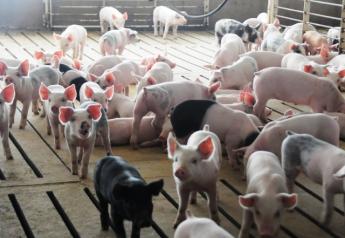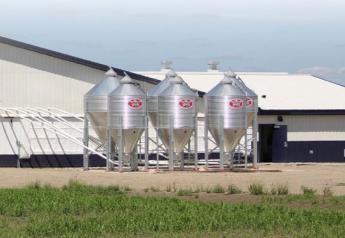Colombia and Chile Offer Untapped Potential for U.S. Pork Industry

When it comes to exports, the conversation often comes down to who’s the most cost-efficient producer. But new studies show U.S. pork will need to differentiate itself beyond being a low-cost supplier if it wants to continue to grow its market share in an increasingly competitive pork market.
There’s no question exports add value to pork producers’ bottom line — to the tune of more than $60 per head of each hog produced in 2021. That’s one reason why the industry has prioritized international market growth as one of the key priorities for Pork Checkoff-funded investments by focusing on the momentum and the value seen from what’s exported abroad.
“For a number of years, the National Pork Board has strategically partnered with Gira, a global meat consultancy firm that specializes and provides key insights into what's happening in the global protein sector, which of course helps us to understand which markets to best target for opportunity,” says Courtney Knupp, vice president of international market development at the National Pork Board.
Over the past few years, the partners have worked to unlock key insights into Southeast Asia, Central America and South America. This initiative has brought forth two new studies in 2022 that delve into Colombia and Chile.
“The insights that we've gleaned are really helping us to best position U.S. pork versus pork of other origins for imported demand,” Knupp says.
The research looks at three crucial areas where U.S. pork can stand out among its competitors, including sustainability, customer service and product availability, packaging and consistency. Request a copy of the report on porkcheckoff.org.
Why Chile and Colombia?
It’s important to note the U.S. has free trade agreements with both Chile and Colombia, explains Dermot Hayes, an economist at Iowa State University.
“Both countries rely on imported feed, and that means their production costs are far higher than ours. Both of them are growing at over 10% a year. With rapid economic growth comes rapid consumption of proteins,” Hayes says. “Beef is expensive all over the world. Pork is an inexpensive alternative to beef.”
Because of these reasons and more, consumers are rapidly increasing their consumption of pork in these two countries.
“We've got to start looking at these second- and third-tier markets, and building and strengthening the U.S. position there,” says Rupert Claxton, meat director at Gira. “Chile and Colombia are two strong South American import markets with very different situations.”
Colombia has a free trade agreement advantage over other importers, he notes. Meanwhile, in Chile, there’s more competition in a growing import market. In addition, the Brazilians have a direct land route in the market.
“Brazil has been competing not just on price, but also in their ability to supply in a short lead time, especially in the world we're in today where international shipping is disrupted, expensive and unreliable,” Claxton says.
That’s why he says it’s important for the U.S. to understand how and to what scale those markets will develop and what products they may be looking for.
“You also need to understand who your competitors are,” Claxton adds. “My concern at the moment is as China pushes back on the import volumes it needs and then pushes again, the other major exporters around the world are looking for other markets.”
In 2020-21, China was an enormous export market, Hayes points out.
“We jumped on that bandwagon as did the Europeans. That left the South American markets high and dry – they were a little unhappy with how that process evolved. Now we are trying to get back into that market, but we didn’t treat them as loyal customers before,” Hayes says.
Claxton says that’s why it’s important to make sure there’s enough product for these smaller quantity markets and not just chase the higher dollar opportunities. China won't consistently buy pork from the U.S., so Claxton says the U.S. will need the other opportunities.
“Chile and Colombia are in your time zone, your language bracket, and you've got some really good advantages in proximity, with the exception of Brazil,” Claxton says. “So, you need to find ways to leverage those strengths going forward.”
Key Insights to Consider
As competition increases in second- and third-tier markets, Claxton says the U.S. must present itself better if it wants to hold that market share and grow with those markets in the future.
“One of the things that stood out to me was the expectation that many have that these countries are poor, low-value South American markets, and that they are pleased to see U.S. pork when it turns up in any form,” Claxton says. “Actually, the sophistication of the markets has improved considerably. And they're looking for better service, better support and better reliability.”
Although these markets do take low-value products, Claxton says the study showed it’s clear they are looking for better quality, better presentation and better packaging.
Being the lowest cost supplier is not necessarily the strength of the U.S. in the long term, Claxton points out.
“You have to compete on the strengths of the U.S. industry – the quality, consistency, and all the things that go behind that, whether that's sustainability or whether that's the fact that you supply the right product at the right time and do more effort around that to hold market share. It’s not just about having a very cheap product that you can push into the market, but encouraging that market to want to pull it,” Claxton says.
The topic of sustainability keeps popping up, too, Knupp says. In Chile and Colombia, customers may not be willing to pay for this yet, but they are starting to ask the question and seek more information about U.S. pork’s sustainability practices.
“What will greatly benefit the U.S. pork industry is if we can celebrate our sustainability initiatives. We have a lot going on in the United States that our pork producers do each and every day. We have a great story to tell,” Knupp says.
And now is the time to package that for the international market, she adds.
“Sustainability is something that not just advanced markets care about today. All markets will care about it in the future. We really need to be clear on our message management, and the resources and education that we have to offer our global consumers that are asking for it,” Knupp says.
What’s Next?
The National Pork Board will round out the in-depth country reports in 2023 with the countries that are part of the Central America Free Trade Agreement with the Dominican Republic. These countries include Costa Rica, El Salvador, Guatemala, Honduras, Nicaragua and the Dominican Republic.
“There's a lot to explore in those key markets to make sure we best approach those individual markets to maximize the advantage not only from our tariff advantage with our free trade agreement, but also in helping to grow consumption and provide a quality pork product,” Knupp says.
National Pork Board’s partnership with Gira is key, she adds, to continue providing market insights. Because of these studies, U.S. exporters have critical information at their fingertips to best take advantage of the opportunities in the international marketplace, especially as global factors change over time.
Read More About U.S. Pork Exports:
China’s Growing Need for Protein: New Study Excites U.S. Pig Farmers
What Do International Pork Customers Really Want?
Pork Exports: How Much Does Taste Matter?
It’s Anyone’s Game: How Will the U.S. Pork Industry Diversify Pork Exports?
An Inside Perspective on U.S. Pork in Mexico
Market Opportunity Awaits in the United Kingdom







